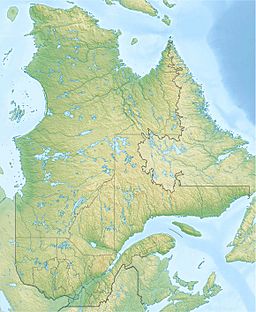Lac Dummy facts for kids
Quick facts for kids Lac Dummy |
|
|---|---|
| Location | Outaouais, Quebec, Canada |
| Coordinates | 46°03′13″N 75°23′57″W / 46.05361°N 75.39917°W |
| Type | lake |
Lac Dummy is a beautiful natural lake located in the Outaouais region of Quebec, Canada. Lakes like Lac Dummy are important parts of our planet's freshwater systems. They provide homes for many plants and animals. People also enjoy lakes for fun activities and to connect with nature.
Contents
What is Lac Dummy?
Lac Dummy is a freshwater lake. A lake is a large body of water surrounded by land. Unlike rivers, lakes do not flow continuously in one direction. They are usually fed by rivers, streams, or rainfall. The water in lakes can stay there for a long time.
Where is Lac Dummy Located?
Lac Dummy is found in the Outaouais region. This area is in the western part of Quebec, Canada. Quebec is a large province known for its vast forests and many lakes. The Outaouais region is especially famous for its natural beauty. It has many outdoor activities available.
What Kinds of Animals Live in Lakes?
Lakes like Lac Dummy are bustling with life. They are home to many different creatures. The types of animals depend on the lake's size and location.
- Fish: Many kinds of fish live in lakes. Common ones in Canadian lakes include trout, bass, and pike. These fish find food and shelter in the lake's waters.
- Birds: Water birds often visit or live near lakes. You might see ducks, geese, and loons. Loons are known for their unique calls. They dive into the water to catch fish.
- Mammals: Some mammals also depend on lakes. Beavers build their homes, called lodges, in lakes. Otters are playful animals that hunt for fish and other small creatures in the water.
- Insects and Amphibians: Many insects, like dragonflies, start their lives in lakes. Frogs and salamanders are common amphibians found near lake shores.
How Do Lakes Form?
Lakes can form in several ways over thousands of years. One common way is through the action of glaciers. As huge ice sheets move, they carve out hollows in the land. When the glaciers melt, these hollows fill with water, forming lakes.
Some lakes form when parts of a river get cut off. This can happen when a river changes its course. Other lakes form in volcanic craters or from movements of the Earth's crust. Each lake has its own unique story of how it came to be.
Why Are Lakes Important?
Lakes are incredibly important for many reasons. They play a vital role in our environment and for people.
- Water Supply: Lakes are a major source of freshwater. This water is used for drinking, farming, and industry.
- Ecosystems: They provide essential habitats for a wide variety of plants and animals. The health of a lake affects all the living things around it.
- Recreation: Lakes offer many opportunities for fun. People enjoy swimming, fishing, boating, and kayaking. In winter, some lakes freeze and are used for ice skating.
- Climate Regulation: Large lakes can influence local weather patterns. They can help moderate temperatures in nearby areas.
Protecting lakes like Lac Dummy is very important. We need to keep them clean and healthy for future generations. This ensures that the plants, animals, and people who rely on them can continue to thrive.


